Text
#histoire#history#history in the making#history is awesome#history of science#history stuff#historyposting#today in history#history lesson#connecticut#ukraine#historyporn#history photos#history posting#history lover
2 notes
·
View notes
Text
#histoire#history#history in the making#history is awesome#history of science#history stuff#historyposting#today in history#history lesson#connecticut#usa
2 notes
·
View notes
Text
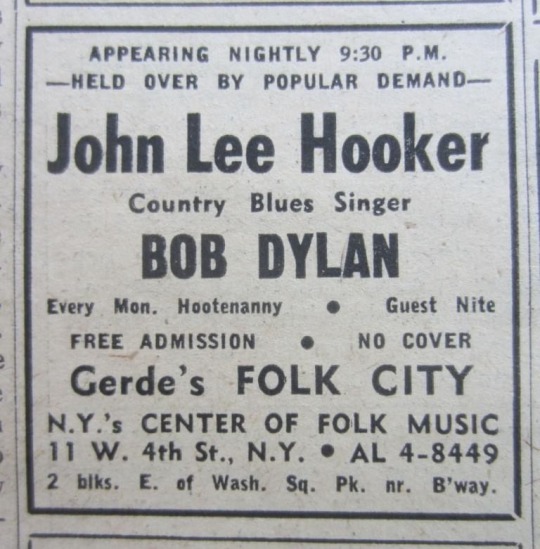


Today in 1961: Bob Dylan took to the stage in New York for his first major gig at Gerde’s Folk City. Dylan was hired to open for none other than the blues icon John Lee Hooker, for a two-week engagement that would go down in history. His setlist included classics like "House of the Rising Sun," "Song to Woody," and "Talkin' Hava Negeilah Blues." He played two other songs that night, identified only as "unknown Woody Guthrie song" and "a black blues," showcasing his incredible range and versatility as a musician. The audience was blown away, including folk legend Dave Van Ronk who attended Dylan's first show and declared, "he was absolutely remarkable." It was a night that would go down in history, but unfortunately, none of the concerts were recorded and amateur recordings have never surfaced.
#histoire#history#history in the making#history is awesome#history of science#history stuff#historyposting#today in history#history lesson#connecticut#new york#new your city#bob dylan#john lee hooker#musician#musica#60s music#70s music#music#rock music#folk rock#folk music
16 notes
·
View notes
Text
#histoire#history#history in the making#history is awesome#history of science#history stuff#historyposting#today in history#history lesson#connecticut#historyporn#history photos#history posting#history lover#history has its eyes on you#history books#historyblr#history blog
0 notes
Text


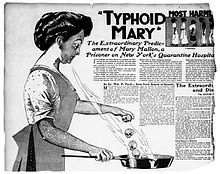
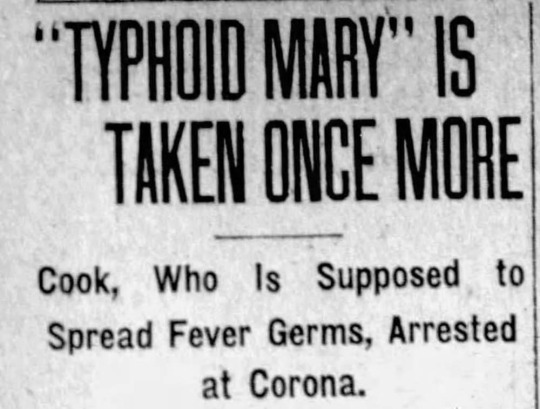
Today in 1915, Mary Mallon, also known as Typhoid Mary, is arrested and returned to quarantine on North Brother Island, New York. Mary was an Irish immigrant who worked as a domestic cook in New York, unfortunately with poor hygiene and no proper sanitation knowledge. She was the first individual in the United States identified as an asymptomatic typhoid carrier. As Mary went from job to job, typhoid outbreaks followed. Mary would be detained and forced to isolate by public health authorities for nearly 30 years, from 1907-1910 and 1915-1938. She was expected to infect between 51-122 people. Her spread of infection caused three confirmed deaths, with unconfirmed estimates up to 50. On March 27, 1915, she was detained for the second time after evading health authorities for the last five years and causing several further outbreaks of typhoid. Today, "Typhoid Mary" is a popular term used to describe anyone unknowingly passing on an undesirable illness.
#histoire#history#history in the making#history is awesome#history of science#history stuff#historyposting#today in history#history lesson#connecticut#new york#typhoid mary#history lover#history teacher#history tag
2 notes
·
View notes
Text
#histoire#history#history in the making#history is awesome#history of science#history stuff#historyposting#today in history#history lesson#connecticut#happy st patricks day#happy st pattys day#ireland#england#historyporn
2 notes
·
View notes
Text
Today in history! The Boston Massacre
#histoire#history#history in the making#history is awesome#history of science#history stuff#historyposting#today in history#history lesson#connecticut#massachusetts#boston massachusetts
0 notes
Text




Today in 1996, the first-ever Pokémon video game, "Pocket Monsters: Red and Green," was released for the Game Boy console in Japan. The game was a role-playing game that introduced players to the world of Pokémon. The game was developed over a few years and set the standards for later Pokémon sequels. The game was a huge success in Japan and soon after its release, it was rebranded as "Pokémon Red" and "Pokémon Blue" for international audiences. The North American release of the game took place on September 28, 1998.
#histoire#history#history in the making#history is awesome#history of science#history stuff#historyposting#today in history#history lesson#pokemon#pokémon#pokéblogging#pokéblr#video games#gameboy#tag game#nintendo#game freak
8 notes
·
View notes
Text



Today in 1914, four-year-old Charlotte May Pierstorff is mailed by train from Grangeville, Idaho to her grandparents' house 73 miles away. In the early days of the postal service, there were no clear regulations of what could, or could not be mailed. On January 1, 1913 post offices began accepting parcels over four pounds, and people immediately began testing the limits. There were about seven instances between 1913 and 1915 of people sending their children in the mail. After all, it was cheaper to pay for stamps, rather than a ticket aboard a passenger train. After the Pierstorff incident, where the mailman was a relative, Postmaster General Albert S. Burleson officially banned accepting humans as mail. However, the new regulation did not stop people, and about a year later a woman mailed her six-year-old daughter from Florida to her father's home in Virginia. That was a 720-mile trip, which cost 15¢ in stamps. The popular photos of mailmen carrying babies are staged.
#histoire#history#history in the making#history is awesome#history of science#history stuff#historyposting#today in history#history lesson#connecticut#history lover#historyporn#history photos#history art#history has its eyes on you#history era
1 note
·
View note
Text



Today in 1866, Jesse James holds up his first bank in Liberty, Missouri. He and the James-Younger Gang stole about $60,000 from the Clay County Savings Association. This was the first daylight bank robbery to occur during a peaceful time in the United States. Armed townspeople gathered to go after the bandits, but unfortunately, snow covered their tracks. The money was never recovered, and no one was caught or held accountable for the robbery. The bank building was built in 1859 and still stands today, listed on the National Register of Historic Places. You can now visit the Jesse James Bank Museum in the same location.
#histoire#history#history in the making#history is awesome#history of science#history stuff#historyposting#today in history#history lesson#connecticut#history lover
3 notes
·
View notes
Text

Joni Mitchell wins for "Best Folk Album" at the 66th Annual Grammy Awards, February 4, 2024.
1K notes
·
View notes
Text


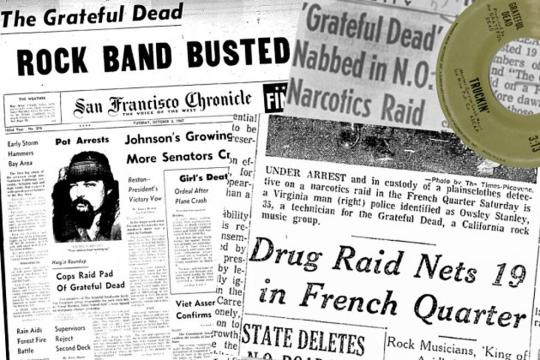
"I'd like to get some sleep before I travel, but if you got a warrant I guess you're gonna come in." Today in 1970 the Grateful Dead is arrested in New Orleans, Louisiana. The band performed at The Warehouse with Fleetwood Mac, before returning to the hotel where cops were waiting with a warrant to search their rooms. Earlier in the day the staff had warned Jerry Garcia to stay clean, inciting a raid would happen. The bust wasn't a huge surprise, since weeks earlier Jefferson Airplane was busted at the same hotel. Nineteen people were caught in the raid. Everyone in the band was arrested, except for Ronald "Pigpen" McKernan and Tom Constanten. The band spent eight hours in jail, even though the bail was ready right away. Upon release, the Dead persuaded Fleetwood Mac to stay for another show, where a bucket was passed through the audience collecting funds for the legal expenses.
The raid led to the inspiration for one of the band's most iconic songs, "Truckin."
#histoire#history#history in the making#history is awesome#history of science#history stuff#historyposting#today in history#history lesson#connecticut#jerry garcia#grateful dead#the grateful dead#new orleans#deadhead#history is all you left me#history lover#history aesthetic#history will say they were best friends#history drama#history daily#fyp#history geek#musician#jam bands#history has its eyes on you#history era#history rant#history repeats itself#history today
3 notes
·
View notes
Text
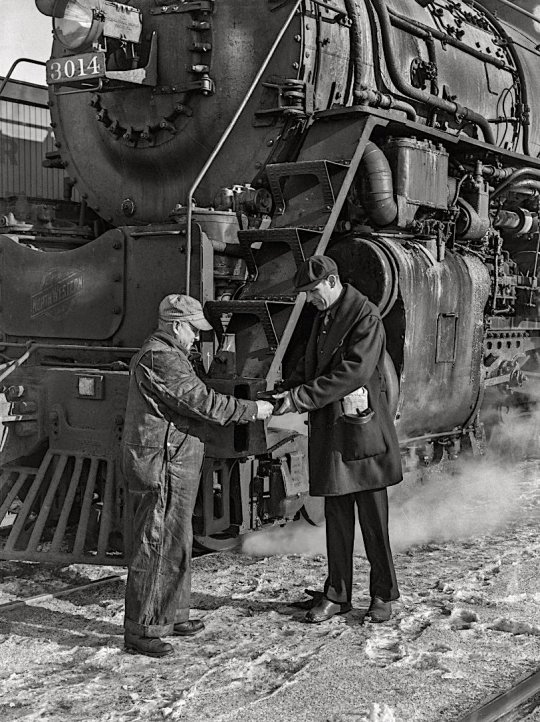
"Conductor handing engineer copy of train orders before a Chicago and North Western freight pulls out for Clinton, Iowa. Since the track between those points is under automatic train control, the engineer hands the conductor the key to the automatic train control lock of the engine. The conductor will keep the key in the caboose until the train arrives at its destination." Photographed January 1943 in Chicago by Jack Delano for the Office of War Information.
121 notes
·
View notes
Text
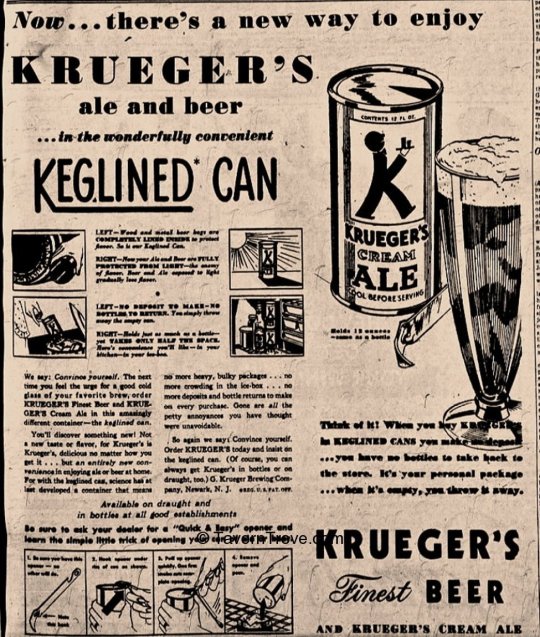



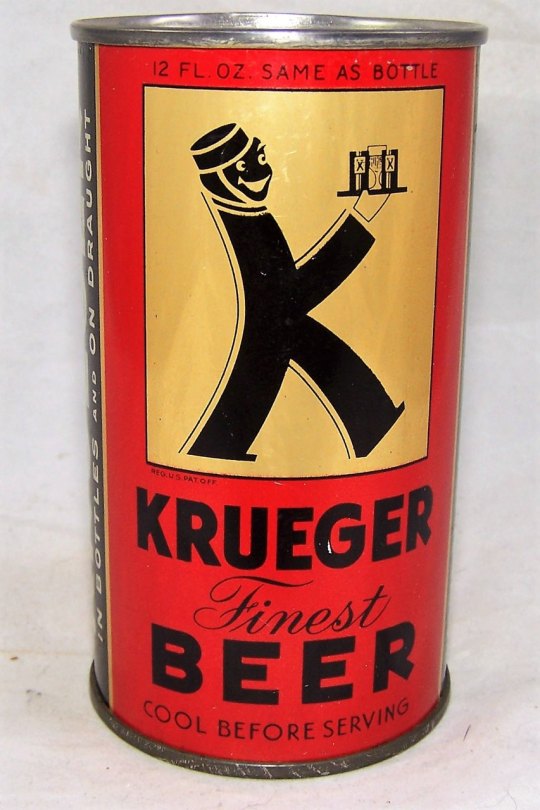

Today in 1935, Gottfried Krueger Brewery sells the first canned beer in Richmond, Virginia. The American Can Company began experimenting with canned beer in 1909, but the cans couldn't withstand the pressure from carbonation. Right before the end of prohibition in 1933, the company developed a "keg-lining" technique coating the inside of the can, like a keg. Kruger had been brewing beer since the mid-1800s, and when first contacted by American Can they initially disliked the idea. However, American Can agreed to install the equipment for free, so it would be no loss for Kruger. Shockingly, canned beer was an immediate success, with a 91 percent approval rating from the public. By the end of 1935, 37 breweries followed suit as cans were easier to stack and transport, cheaper, and kept beer fresher.
#histoire#history#history in the making#history is awesome#history of science#history stuff#historyposting#today in history#history lesson#connecticut#beer#virginia#history is all you left me#history lover#history geek#fyp#history drama#history daily#history will say they were best friends#history aesthetic
2 notes
·
View notes
Text



Today in 1897 Elva Zona Heaster is found dead in Greenbrier County, West Virginia. The resulting murder trial would be the only time in U.S. history where the alleged testimony of a ghost helped secure the conviction. What?! In October 1896, Zona met Erasmus Stribbling Trout Shue, and they married shortly after. The initial result of death was from childbirth and she would be buried the next day. Zona's mother, Mary Jane Heaster claimed her daughter's ghost came to her and told her that Erasmus had murdered her. After this event, Mary visited the local prosecutor, and whether he believed the ghost story or not, he reopened the case. It was determined that a complete examination of the body was not made and an exhumation was ordered. The second autopsy found Zona's neck broken, and her throat had finger marks. Shue was found guilty on July 11, 1897, and sentenced to life in
prison. Many people in the community believed the ghost story, however "the Greenbrier ghost was never mentioned by the prosecution and played no part in the case against Shue." Believe it, or don't history is fascinating.
#histoire#history#history in the making#history is awesome#history of science#history stuff#historyposting#today in history#history lesson#connecticut#history is all you left me#history lover#history will say they were best friends#west virginia#history aesthetic#history has its eyes on you#history era#history rant#history repeats itself#history today#ghost#spooky#spirituality#spiritual awakening
7 notes
·
View notes
Text



Today in 1908 Katie Mulcahey is arrested for lighting a cigarette in public and is fined $5. The day prior the Sullivan Ordinance was passed in New York City barring the management of a public place from allowing women to smoke within their venue. A woman smoking a cigarette was considered dangerously sexual, immoral, and not to be trusted. This short-lived law depicted society's response to women gaining freedom at the turn of the century. When Mulcahey appeared in front of the judge she said, "I've got as much right to smoke as you have. I never hears of this new law, and I don't want to hear about it. No man shall dictate me." Katie was the law's only victim, although other women may have restricted smoking in public due to the ban. The Sullivan Ordinance came to an end after two weeks, vetoed by New York's mayor.p
#histoire#history#history in the making#history is awesome#history of science#history stuff#historyposting#today in history#history lesson#connecticut#history geek#new york#history is all you left me#history aesthetic#history has its eyes on you#history era#history rant#history repeats itself#history today#youtube#thank you#usa#history is fun#history of music#cigarette#history lover#history will say they were best friends#vintage
7 notes
·
View notes
Text


Today in 1524, Italian explorer Giovanni da Verrazzano sailing under the French flag finds the east coast of North America. King Francis I of France was interested in finding a direct sea route to the Pacific Ocean. Verrazzano initially set out to find a westward passage to China, instead, he would be one of the first Europeans to see the New York and Narragansett bays. He was the first to explore the Atlantic Coast of North America between Florida and New Brunswick including the aforementioned bays. Verrazano's return to France on July 8, 1524, gave King Francis I his nation's claim to the New World. He would sail to the New World again in the spring of 1528, where he would meet his unfortunate end. Verrazzano would anchor off an island in the Lesser Antilles, apparently Guadeloupe, and arrive on shore where he was captured and killed by cannibals. The Verrazano-Narrows Bridge in New York is named after this Italian explorer.
#histoire#history#history in the making#history is awesome#history of science#history stuff#historyposting#today in history#history lesson#connecticut#history has its eyes on you#history repeats itself#history is fun#history is all you left me#history lover#history will say they were best friends#history aesthetic
4 notes
·
View notes